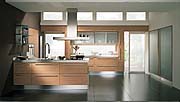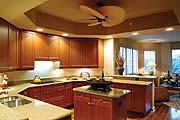
Issue: 3/04
Trends in luxury high-rise kitchens today all have to do with the optimum blending of form and function. Affluent consumers are well-traveled as well as exposed to a plethora of media coverage on home design and improvement topics transforming them into demanding and savvy purchasers.
At the same time, manufacturers have responded to consumers' desires to incorporate their individual preferences into kitchens by developing new products that often can be customized to meet varied lifestyle needs.
The following is a detailed look at the trends in luxury high-rise kitchens, as well as insights into how they reflect directions in the single-family home market.
Layout and Style
"Overall, the kitchen is becoming a major social space," Michael Griffin, COO of Fugelberg Koch Architects Inc., Winter Park, FL, said. "The family room and kitchen are fused into one space. The kitchen/family room is the hearth and heart of the home."Large tables or eating areas are often included, according to Griffin, to reflect the space's role as a socializing center and family gathering area. Televisions are often incorporated into the kitchen and positioned to be visible to those seated at the eating bar.
In properties handled by Griffin's organization, there is an equal division between preferences for traditional and contemporary styling. "It's all over the board at the luxury level. Buyers are looking for styles that reflect their own taste, character and personality," he said. Because owners spend so much time at home, they are more interested in making their environments their own. The common wisdom at play is, "If I like it, so will someone else." The concern for resale value is not centered on style as much as a conscious effort to purchase long-lasting, high-quality products and well-known brands.
"It's not that kitchens are getting increasingly larger, it is that they are better designed in that they are more functional spaces," explained Ray Rouco, president of Mia Cucina, Miami, FL. The layout of the kitchen and its components is all about convenience. "An island or peninsula with eating bar is standard," Ruoco said.

Appliances
When it comes to appliances, professional-look, commercial-style units dominate the luxury market. "Commercial-style appliances, whether it is a rental or an owned luxury unit, are the most popular," Griffin said.There are many specialty appliances available today that go beyond the standard refrigerator, range and dishwasher. The number of appliances included is not necessarily a matter of price, but of space. "In 4,000- to 6,000-sq.-ft. apartments, the kitchens are large, and often specialty appliances are included. When the apartment is 1,500-2,000 sq. ft., the kitchens are smaller, and though high-quality brands are used, the number of appliances is limited."
Built-in cappuccino and espresso makers, multiple dishwashers, steam ovens, wok burners, grill and griddle components, deep fryers and warming drawers are some of the most popular luxury items available today.
"Regardless of what the brand is, the most prized finish remains stainless steel, with the built-in look, in which appliances are integrated into the cabinetry with matching wood panels, running second," according to Robert M. Swedroe of Robert M. Swedroe Architects & Planners, Miami, FL.
Sinks and Faucets
The stainless steel look is carried through in sinks, according to Ruoco, to match the appliances. "The trend in sinks is to have a large single bowl or a double bowl unit that positions a large rectangular bowl next to an oval," Swedroe said.Stainless steel sinks are also preferred because of their durability. Lori Mrozinski, showroom sales training manager, Central Region, for Elkay Manufacturing Co. based in Oak Brook, IL, explained that "undermount stainless steel sinks are hugely popular in high-end home design and complement both contemporary and traditional room themes. Very popular now are the capacious 8- and 10-inch deep undermount sinks with one or two full-size bowls. It's the durability of stainless steel that attracts consumers. A favorite in stainless steel sinks is the brushed satin finish. The working surface is going to get scratched. The brushed satin finish hides the scratches."
"The gourmet kitchen look that is seen in single-family custom homes is most desired," said Griffin. "Part of that look is the integration of stainless steel sinks to complement commercial-styles appliances. It's the look of the sink that matters." The range of styles and shapes offered by various manufacturers is a reflection of the high-end preference for products that combine pleasing form and functionality.
The gourmet luxury kitchen, of course, usually includes more than one sink, with a second smaller vegetable or salad sink installed in an island or peninsula, according to Swedroe. He added that in utility rooms, the oversized, rectangular or square farmhouse-style sinks are most in demand today.
Faucets are selected also for their functionality and style. Faucets can add personality to or extend the style of the kitchen, from large, heavy duty, professional looks to vintage or traditional styled models.
"Faucets with added character, such as those with finishes in the more exotic metals like pewter and copper, are increasing in popularity," Griffin said.
Luxury kitchens enjoy added special features in faucets and related fittings, such as built-in filters, hot water dispensers, soap dispensers and garbage disposals.

Cabinetry
"The color of cabinetry has moved away from the all white of a decade ago to high-gloss lacquered wood," Swedroe said.The preference for natural wood finishes is, in part, a response to the embracing of stainless steel accents and appliances. The wood adds a feeling of warmth to the space, as well as texture via the graining patterns that counter the hard, cool, smooth look and feel of metal.
The mixing of materials, sizes and shapes is important. "Color and materials are closely related," said Griffin. "The trend is toward the substantial use of natural materials." Solid wood cabinetry may be complemented by a backsplash of glass or ceramic tiles and granite countertops. Glass insets in cabinet doors can be textured or frosted to add visual interest.
"A variety of materials and wood lacquers are used in the luxury kitchen today. The color of the kitchen is influenced by location as well," Ruoco said. "In Miami, most high-rises are built along the water, so the interiors are designed to look bright to complement the ocean view."
Often, woods and wood finishes are mixed and wall cabinet heights are varied to produce the "furniture look"--the illusion of freestanding units rather than long, uninterrupted runs of connected countertops and cabinetry.
"Kitchens no longer consist of long runs of horizontal surfaces. Work counters vary in height," Swedroe said.
"A decade ago, a luxury high-rise apartment would offer either a name-brand appliance or a name-brand cabinetry system. Today, both are required. The quality of the cabinetry and appliance brands chosen is extremely important in distinguishing condominiums in the eyes of buyers," Craig Studnicky, a partner in International Sales Group, Miami, FL, said.
"At the luxury level, cabinetry includes a variety of different accessories in drawer systems and incorporates high-quality hardware when it comes to drawer slides and hinging," Ruoco said.
Storage details include double, deep drawer units for pots and pans, wood cutlery inserts that organize utensils and linear backsplash bars on which accessories are suspended for easy access. Cabinet hardware is selected for its quality, from drawer slides to hinges and interior cabinet organizer elements, such as lazy susans and pullout containers.
Countertops
The experts agree that the rage in countertops today is natural stone. "Five years ago, granite countertops were rare," Studnicky said. "Now, it's the standard in luxury units." Granite is durable, scratch resistant and comes in a wide range of colors and patterns. Engineered quartz, which has the look of natural stone and is indeed made with natural quartz as well as resin material to insure a consistent pattern throughout the slab, is a popular alternative.Lighting
When it comes to illuminating the luxury kitchen, a flexible multi-leveled system that provides options for task, general and accent lighting is commonplace. "There are three types of lighting fixtures standard in high-end kitchens today," Swedroe said. "There is a central fixture above the island, which is often a decorative piece chosen by the interior designer. Downlights that hold lamps such as MR 16s are directionally focused and installed in a greater quantity than had been in years past. Finally, there's under-cabinet lighting for illuminating tasks on countertops."Swedroe noted that many kitchens include even further aesthetic touches. "Lighting inside glass-doored cabinets so objects displayed can be showcased is commonplace as well," he said.
Second/Summer Kitchens
In addition to the main kitchen, many luxury apartments and condominiums enjoy summer kitchens or eating bars on terraces, especially in warm climates. "The summer kitchen would include a stainless steel outdoor grill, icemaker, refrigerator and sink," said Swedroe. "Sometimes the main kitchen is also positioned to open up to the terrace with inside/outside bar counters so food and drink can be easily passed through."
High-Rises Reflect Single-Home Trends
Barry Sugerman of Barry Sugerman Architect, Miami, FL, designs luxury custom homes, with half his business coming from remodeling and the other half from new construction. His listing of trends in high-end, single-family homes mimics those found in luxury high-rises:- The kitchen opens into the family room.
- The style mixes a variety of woods and other materials.
- The appliances are clad in stainless steel.
- The kitchen has more than one sink, most are stainless steel and the main sink is larger than it was a decade ago.
- The lighting system is multi-leveled for flexibility.
- There is a color TV in the kitchen, often viewable from the family room.
- Appliance amenities include wine coolers and refrigerated drawers.
- Granite is the countertop material of choice. Thicker countertops, often with bullnosing, are the current trend.
Even luxury rental units in high-rises enjoy the same trends found in both condominiums and single-family homes. "Of course, there is more freedom in selecting products and custom work in owned units," Griffin said. "Rental units have limited product selections as to what can be installed, and those selections are usually more coordinated with the architecture and theme of the building."
Luxury kitchens in today's high-rises are more in tune with individual owner's tastes than ever before. And manufacturers are responding with a range of quality high-end products to provide owners with fashionable and functional choices.
